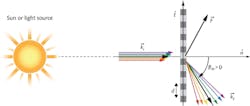Space and Astronomy: Diffractive solar sails could outperform reflective-metal-coated sails
GROVER SWARTZLANDER
The abundant untapped momentum of solar photons is becoming increasingly attractive as a means to propel spacecraft with an attached solar sail. For example, the upcoming NASA Near Earth Asteroid mission known as NEA Scout will make use of an 86-square-meter sail attached to a reconnaissance platform (see Fig. 1). It is expected to be launched in 2018 as a CubeSat aboard the inaugural flight of NASA's new rocket, the so-called Space Launch System.
Decades of mission studies have examined how microscopically thin films ranging from meters to kilometers in extent may make use of freely available sunlight for near-Earth, interplanetary, and interstellar space travel. In nearly all cases, a reflective metallic coating was considered as the mechanism for transferring momentum from photons to the sail. Here, we describe an alternative to reflective sails, namely diffractive sails.1 Advances in the design and fabrication of broadband high-efficiency single-diffraction-order gratings and active electro-optic control may make diffractive sails an attractive alternative to reflective sails.
Limitations of metallic sails
Let us first examine some of the shortcomings of metallic sails. In practice, metals absorb a fraction of the light beam and therefore heat the sail, especially as the sail is brought closer to the sun to achieve larger forces or when high-power laser propulsion is required. Heating and temperature cycling cause structural concerns.
Even without heating concerns, a reflective sail is limited by the law of reflection, which always produces a radiation pressure force in the direction normal to the sail surface. Spaceflight designers seek to achieve a large component of force that is perpendicular to the direction of the sun, requiring a tilt angle of roughly 35° with respect to the sunline. If this component is tangential to a Keplerian orbit, quasi-logarithmic spiral-type trajectories are possible, allowing the sailcraft to raise its orbit (for an Earth-to-outer-planet rendezvous mission) or lower its orbit (for an Earth-to-inner-planet mission). Tilting, however, lessens the power and, hence, the force on the sail by 20%. Roughly 75% of the available electromagnetic momentum may be converted into the tangential component.
Finally, for a reflective sail, the photons are generally used only once—that is, they are either reflected back into space or absorbed in the metal.
Advantages of using a diffractive surface
In principle, these disadvantages may be addressed by replacing the reflective coating with an active diffractive surface. The rainbow-like spectral dispersive properties of diffraction gratings are familiar to anyone who takes notice of the color separation of light scattered from the surface of a compact disc.
Recent advances in grating design and manufacturing provide various means to efficiently diffract light into a diffraction order, and active control has been demonstrated. A transmissive diffraction grating is particularly attractive for a lightsail because the diffracted photons may be used again and again. For example, some transmitted light may be converted to solar-electric power, with the rest diffracted again by a second grating to impart additional momentum to the sailcraft. Heating of the sail material is less of a concern because a transmissive diffractive sail may absorb very little light.
Tilting of the sailcraft may also become unnecessary, since a diffraction grating naturally redirects photon momentum even when the grating is directly facing the sun (see Fig. 2). This is understood by use of the well-known grating equation that relates the diffraction angle to the ratio of the wavelength and grating period. For a first order grating, the diffraction angle can approach 90° as the ratio approaches unity. Unlike a reflective sail, a grating may therefore convert up to 100% of the electromagnetic momentum into the desired transverse component to raise or lower an orbit. Maintaining a high efficiency over a band of solar wavelengths where the momentum is greatest (for example, 250–750 nm) is a topic of further research.Achieving an optimal trajectory is part of the art called "rocket science." In principle, the momentum-transfer efficiency components must be varied throughout portions of a spaceflight to achieve desired objectives. As suggested above, such changes require attitude adjustments of a large reflective sail. However, an active diffractive sail may maintain the sun-facing orientation to provide a large force, while changing the efficiency components with nonmechanical means. One way of doing this is by the construction of an array of individually controlled gratings. A simple binary control scheme may be envisioned whereby each grating is switched from the +1 to -1 order, in effect providing a varying tangential efficiency.
As materials scientists develop space-hardened arrays of lightweight active diffractive sheets, the attraction of diffractive sailcraft will grow stronger. In the meantime, mission planners may seek out the particularly beneficial cases where diffraction and reusable photons provide extraordinary advantages over reflective sails.
REFERENCE
1. G. A. Swartzlander Jr., JOSA B (2017); https://doi.org/josab.34.000c25.
Grover Swartzlander is a professor at the Rochester Institute of Technology, Rochester, NY; e-mail: [email protected]; www.cis.rit.edu/~grovers.

